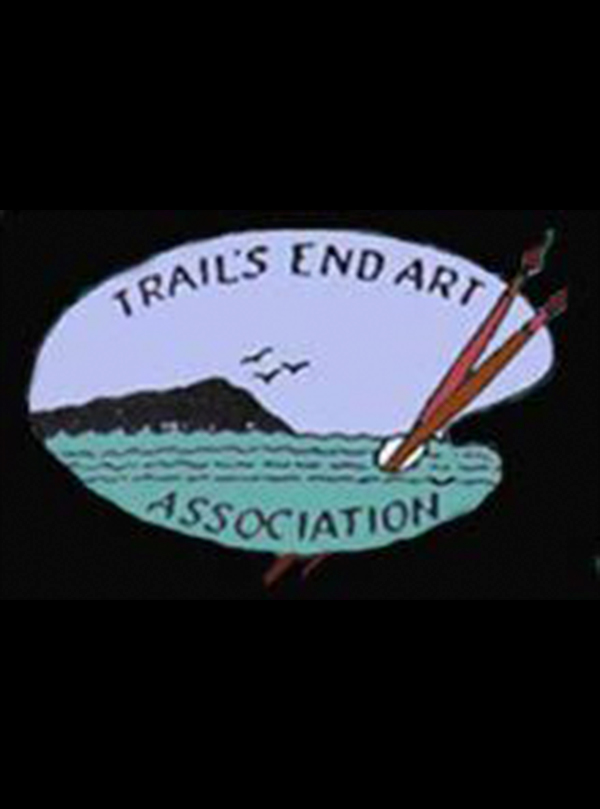Trails End Art Association is the longest active art association on the Oregon Coast. We provide classes and workshops, gallery shows and special events. New members are warmly welcomed!
From “A History of Trails End Art Association: The Beginnings,” published in July 1990 by Sylvia Coumont:
In the early 1950s, the art climate in this area was vastly different from what it is today. With the exception of a few galleries in Cannon Beach, there was very little evidence of any interest in art on the north Oregon coast.
However, it was at that time that a group of people in Seaside who were interested in pursuing art started getting together to hold painting sessions, sharing their knowledge with one another and encouraging those who had little experience in art. They met in one another’s homes during the first year or so and eventually decided to form an organization that they called Trail’s End Art Association. Most of the group were from Seaside and the name was chosen to honor Seaside, which was known (at that time) as the Trail’s End City because of its association with the Lewis and Clark Trail.
Included in that original group of about 20 were several accomplished artists who freely shared their knowledge and techniques with those of less experience.
It appears from the minutes of the meetings and from newspaper accounts that it was a real up-and-coming organization. By the end of April 1950, following their organization in February of that year, the Seaside Signal reported that several weekly classes. That first year also included a paint-out at Ecola Park with members of the Oregon Society of Artists and Pacific Art Guild of Astoria. Other outstanding events that first year were two art exhibits, one with the Seaside Garden Club annual show and the other with the AAUX annual art exhibit. There were also demonstrations by one of Oregon’s best-known artists, Arthur Selander, on August 35 at the new Gearhart School. By September 15th of that first year, membership had increased to 50, and by the end of the year to 1963 it increased to 63. (In 2007 there were 175 members).
FINDING AND BUYING A HOME OF OUR OWN
Members were still meeting in one another’s homes for painting sessions, but what they were really wishing for was a place where they could meet, paint, hold classes, and keep their easels, paints and other equipment and materials. On June 19, 1952, a general meeting was held to discuss finding such a place. When Rosella Ober, one of the members, reported that the old two-room school building in Gearhart could be obtained at a nominal cost, the meeting was immediately adjourned and everyone went to Gearhart to look at the building.
The building had fallen into disrepair after it was vacated upon completion of the new Gearhart School. But I offered wonderful possibilities with one room to be used as a studio and the other as a gallery. Eight of the original members offered to advance funds to cover a large part of the purchase price, and the association signed a mortgage for the balance, giving a second mortgage to the members who loaned money toward the purchase. For the record, they were J.J. Miscoe, Rosella Ober, Myrtle Meyer, H.E. Plummer, Dr. Martha Lowe, Leona Evans, Lynette Ross, and Jane Keeler.
Before purchasing the building, the organization became a non-profit corporation registered under the laws of the State of Oregon, and on September 15, 1952, it was unanimously voted to authorize Mike Miscoe to arrange the purchase of the building at the best terms available.
The building had been used last as an extra classroom and gym while the school was still located on Ridgepath. After being vacated when the school moved, it had served a number of purposes, including being used for square dances.
A tremendous amount of work was needed to put it in shape as a studio and gallery. According to the story in the Seaside Signal, “Members turned out in a body to put their house in order.” Brushes and sketchbooks were traded for hammer and nails; a house-jack was obtained to raise one corner of the building and place new cement blocks. Windows still containing glass were taken out and installed in the room planned as a studio; the roof was patched in the leakiest places.” The members worked feverishly as American Art Week was scheduled for November 8 and 9, and they planned to hold an open house in observance.
Apparently, they were successful because a story in the signal states that 200 persons signed the guest book on those dates while members demonstrated their skills for visitors.
PAYING THE MORTGAGES
The next project was paying off the mortgages. Those early members were really motivated: rummage sales, bake sales, paintings donated by members and sold to raise funs all contributed to the treasury. And in the minutes of the meeting of July 6, 1953, it was reported that the first mortgages had been paid off. Later on, the members who had contributed to the purchase price were also repaid.
CREATING ART TOGETHER AT THE TRAIL’S END CENTER
During the following years, it appears from newspaper articles that the Center was alive with activity: art exhibits in the gallery, including a traveling exhibit of watercolors by Oregon’s best know artists; displays in the Pacific Power and Light building on Broadway and other downtown locations; paint-outs at various sites; and of course, classes in all media, mostly without charge to members. These classes included summer classes for children taught by Leona Evan for several years with an attendance of about 22 students. Minutes of the meetings during these years report a membership of as many as 75.

